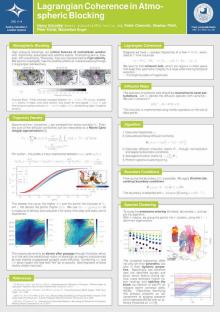Lagrangian Coherence in Atmospheric Blocking
Henry
Schoeller
FU Berlin, Institute of Meteorology, Department of Geosciences, Berlin, Germany
Poster
Atmospheric Blocking - also known as Quasi-Stationary Atmospheric States (QSAS) - exert a major influence on mid-latitude atmospheric circulation and are known to be associated with extreme weather events. Previous work has highlighted the importance of the origin of air parcels that define the blocking region, especially with respect to non-adiabatic processes such as moisture transport and latent heating. So far, an objective method for clustering the individual Lagrangian trajectories passing through the QSAS into larger and - more importantly - spatially coherent air streams has not been established, which is the focus of our current work.
Coherent sets are regions in the phase space of dynamical systems that keep their geometric integrity to a large extent during temporal evolution. We extract a low-dimensional representation of the Lagrangian data via diffusion maps and cluster the trajectories in this representation to estimate coherent sets. Our implementation adapts the existing methodology to the non-Euclidean geometry of Earth's atmosphere and its challenging scaling properties. Several example cases are investigated.
The results confirm the existence of spatially coherent feeder airstreams differing with respect to their dynamical properties and, more specifically, their latent heating contribution. Air streams experiencing a considerable amount of latent heating occur mainly during the maturing and maintanence phases of the QSAS and contribute to its stability. In our example cases, trajectories also exhibit an increase in density when passing through the blocking region during its maintanence phase, which is in line with the common understanding of QSAS as regions of high stability.
Coherent sets are regions in the phase space of dynamical systems that keep their geometric integrity to a large extent during temporal evolution. We extract a low-dimensional representation of the Lagrangian data via diffusion maps and cluster the trajectories in this representation to estimate coherent sets. Our implementation adapts the existing methodology to the non-Euclidean geometry of Earth's atmosphere and its challenging scaling properties. Several example cases are investigated.
The results confirm the existence of spatially coherent feeder airstreams differing with respect to their dynamical properties and, more specifically, their latent heating contribution. Air streams experiencing a considerable amount of latent heating occur mainly during the maturing and maintanence phases of the QSAS and contribute to its stability. In our example cases, trajectories also exhibit an increase in density when passing through the blocking region during its maintanence phase, which is in line with the common understanding of QSAS as regions of high stability.

Poster file
schoeller-henry-blocking-poster.pdf
(3.51 MB)
Meeting homepage
